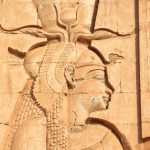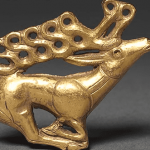 Technology
Technology  Technology
Technology  Humans
Humans 10 Everyday Human Behaviors That Are Actually Survival Instincts
 Animals
Animals 10 Animals That Humiliated and Harmed Historical Leaders
 History
History 10 Most Influential Protests in Modern History
 Creepy
Creepy 10 More Representations of Death from Myth, Legend, and Folktale
 Technology
Technology 10 Scientific Breakthroughs of 2025 That’ll Change Everything
 Our World
Our World 10 Ways Icelandic Culture Makes Other Countries Look Boring
 Misconceptions
Misconceptions 10 Common Misconceptions About the Victorian Era
 Mysteries
Mysteries 10 Strange Unexplained Mysteries of 2025
 Miscellaneous
Miscellaneous 10 of History’s Most Bell-Ringing Finishing Moves
 Technology
Technology Top 10 Everyday Tech Buzzwords That Hide a Darker Past
 Humans
Humans 10 Everyday Human Behaviors That Are Actually Survival Instincts
 Animals
Animals 10 Animals That Humiliated and Harmed Historical Leaders
Who's Behind Listverse?

Jamie Frater
Head Editor
Jamie founded Listverse due to an insatiable desire to share fascinating, obscure, and bizarre facts. He has been a guest speaker on numerous national radio and television stations and is a five time published author.
More About Us History
History 10 Most Influential Protests in Modern History
 Creepy
Creepy 10 More Representations of Death from Myth, Legend, and Folktale
 Technology
Technology 10 Scientific Breakthroughs of 2025 That’ll Change Everything
 Our World
Our World 10 Ways Icelandic Culture Makes Other Countries Look Boring
 Misconceptions
Misconceptions 10 Common Misconceptions About the Victorian Era
 Mysteries
Mysteries 10 Strange Unexplained Mysteries of 2025
 Miscellaneous
Miscellaneous 10 of History’s Most Bell-Ringing Finishing Moves
10 Ancient Origin Stories of the Constellations
Humans have pattern-finding brains. If we look at chaos, our brains will try to impose order on what we are seeing and pick out things that we might recognize. As far as we know, people have always liked to look at the stars, so it is understandable that people have always liked to tell stories about the shapes they see in the heavens. Many of the brightest stars have been organized into constellations, and most of them have an origin story.
Here are ten myths told about the constellations.
Related: 10 Common Myths and Misconceptions About Our Universe
10 Coma Berenices
Most of the constellations date back to the earliest days of human history and have mysterious origins, but there is one named after a known historical figure: Coma Berenices. The name means Berenice’s Hair, which apparently came into being from a sacrifice and an act of theft.
Queen Berenice II of Egypt was the wife of King Ptolemy III in the 3rd century BC. When her husband departed to go to war in Syria, she promised to cut off her hair as an offering to the goddess Aphrodite to ensure his safe return. She shaved her head and laid the locks on the altar to the goddess—but the very next day, the hair was gone.
When the king returned, he was scandalized to discover that his wife’s hair had been pilfered from a temple and demanded an inquiry. To assuage the king’s wrath, the court astronomer Conon came up with a solution—the hair had not been taken by human hands. Instead, the goddess was so pleased with the sacrifice that she had taken the hair and placed it in the sky as the constellation known today as Coma Berenices. This became a popular piece of propaganda for the royal family, with poems written in praise of the queen’s offering and images of the queen with a shaved head.[1]
9 Canis Major
The Greek gods had many pet peeves, and apparently, one of these was logical paradoxes. This is how a good doggy ended up being placed forever among the stars.
According to one version of the legend of Canis Major, Latin for “Greater Dog,” the trouble started with a very wily fox. The Teumessian Fox was harassing the farmers living around the city of Thebes, but everyone who set out to catch it returned empty-handed because it had been fated that the fox would never be caught. To end the reign of the fox, a hunter took along his hunting dog, Laelaps, that was fated to always catch whatever beast it pursued.
This chase created a paradox as either the fox would be caught, and fate would have been undone, or the fox would escape, and fate would be equally proved wrong. To stop the tapestry of fate from being torn apart, the gods placed Laelaps and the fox in the sky, where they could always be running through the heavens but never catching or escaping each other. Fate was saved.[2]
8 Orion and the Scorpion
Orion is probably the most recognizable constellation in the sky because it is so large and so bright. Orion’s belt, in particular, is easy to spot. What is less well-known about Orion is that he is locked forever in a ferocious battle with the constellation Scorpius.
According to Greek myth, Orion was the son of the god Poseidon and one of the greatest hunters that ever existed. He was so proficient that he boasted that he could kill every animal on Earth if he chose. This was the wrong thing to say as Gaia, the goddess and embodiment of Earth, was one of the protectors of all life, and Orion’s boast made her fear for her animals. She created a monstrous scorpion to kill Orion so that her beasts could be safe. The scorpion managed to stab its sting into Orion’s heel and slew the hunter.
The gods placed Orion and Scorpius in the heavens at almost opposite sides of the sky so that as one rises, the other sets in the night sky. The point where the scorpion hit Orion is marked forever by the bright star Rigel.[3]
7 The Pleiades
The Pleiades is a star cluster known as the Seven Sisters. It may be the constellation with the oldest myths attached to it, as similar stories have been found in many widely spaced societies. The Greek myth, as so often does, describes their origin with an attempted seduction.
The Pleiades were originally the daughters of the Titan Atlas and were so beautiful that almost all the major Greek deities had affairs with them at some time or other. The hunter Orion was one person who desired them but could not be with them for fear of Atlas protecting them. Once Atlas was set to hold up the vault of heaven, there was no one to guard the Pleiades, so Orion set out to capture them.
The Pleiades fled, and the gods took pity on them. The sisters were first transformed into doves so that they could fly away from the hunter but were later placed in the sky as a constellation. When Orion was added to the stars, he was placed in a position where he was always chasing the Pleiades but would never be able to catch them.[4]
6 Cancer
“When you aim at the king, you better not miss” is the moral of the story behind the constellation Cancer. The legend of Cancer involves a crab and the Greek hero Heracles.
Heracles was forced to complete twelve nearly impossible labors after killing his wife and children during a bout of madness that had been inflicted on him by the angry goddess Hera. These labors often involved mighty and terrible beasts like slaying the Nemean Lion and capturing the Erymanthian Boar. You might say Heracles was an expert in defeating even the mightiest of animals.
While Heracles was defeating the Lernaean Hydra, a snake with many heads that multiplied every time one was hacked off, Hera decided to wreak her revenge. She sent… a crab. Apparently, the plan had been to nip Heracles and distract him so the hydra could kill him, but the crab failed almost immediately. In one version, Heracles booted the crab so hard it flew into the heavens as the constellation Cancer, while in another, he simply stepped on it, and Hera rewarded her dead crustacean champion by immortalizing it in the stars.[5]
5 Cassiopeia, Cetus, Perseus, and Andromeda
In Greek myths, one of the worst crimes that any person could commit was the sin of hubris—outrageous arrogance. Anyone who boasts that they are better in any way than the gods is invariably cursed to a terrible fate. That is why Cassiopeia, queen of Aethiopia, should have been more careful when she declared that she was more beautiful than the sea nymphs known as the Nereids. Poseidon, lord of the sea, was not going to let Cassiopeia’s vanity go unpunished, so he ordered the monstrous Cetus to attack the coast of Aethiopia.
The king and queen sought out the advice of an oracle to end the attacks, and they were told that there was only one way—they had to sacrifice their beloved daughter Andromeda to Cetus. While Andromeda was shackled on the shore awaiting her fate, the hero Perseus swooped in on the winged horse Pegasus and rescued her, some say by turning the beast to stone with the severed head of Medusa.
Later, Perseus, Andromeda, Cetus, and Cassiopeia were placed among the stars as constellations. To underline the hubris of Cassiopeia, for half of the year, the queen’s constellation appears to hang upside down in the sky.[6]
4 Pisces
The constellation Pisces represents two fish that somehow made their way into the zodiac. How they came to be in the heavens is a tale told by Roman-era authors who refer back to Greek versions of the story.
Typhon was one of the most terrible monsters in all of Greek mythology and is usually described as a vast beast whose head brushes the stars and is covered in coiling snakes. When Typhon attacked the gods, the battle was so fierce that the ground trembled, and the seas writhed and overflowed the land. Only Zeus was able to overcome the monster in the end. The goddess Aphrodite had been in Syria when Typhon began chasing her. Being the goddess of love, Aphrodite and her son Eros decided that their best hope was to flee.
To finally escape Typhon, they leaped into the river Euphrates, where a pair of fish emerged from the waters and carried them away to safety. For their role in the rescue, the helpful fish were placed in the sky to immortalize them.[7]
3 Ursa Major
Zeus was many things, but he was not a faithful spouse. A large proportion of Greek myths involve the tales of Zeus’s affairs, seductions, and rapes of both other supernatural beings and mortals. Hera, Zeus’s long-suffering wife, did not take these dalliances lying down. For every story of Zeus sleeping with someone, there is a story of Hera taking out her wrath on the poor person.
Callisto was a nymph who was in the retinue of the virgin goddess Artemis, who was tricked into sex when Zeus took the form of Artemis to get close to her. Artemis found out about this because Callisto became pregnant. The nymph was cast out, and Callisto gave birth to a son called Arcas.
One day, Zeus was walking in the forest with Callisto when he spotted Hera approaching. To hide Callisto from his vengeful wife, Zeus transformed the nymph into a bear. Hera was not stupid, however, so when she saw Zeus with a bear, she suspected the truth and insisted Zeus accompany her home immediately, leaving Callisto trapped as a bear. It was then that Arcas, a great hunter, stumbled across a bear in the woods and shot it dead with an arrow—not knowing that he had just slain his mother. When Zeus found out about this, he placed Callisto in the sky as the Great Bear and Arcas as the Little Bear.[8]
2 Cygnus
Cygnus, the swan, is one of the easier constellations to spot in the night sky because its stars form a fairly neat cross. There is no single story, however, about how this constellation came into existence.
One of the most famous swans in Greek myth comes from yet another tale of Zeus’s affairs. When Zeus wanted to sleep with Leda, queen of Sparta, he (for unclear reasons) decided that the best way to pursue her was to take the form of a swan. For yet more unclear reasons, he succeeded, and the two made love. Later, Leda gave birth to an egg and, from it, sprung Helen of Troy. Perhaps Cygnus is Zeus as a swan.
Another version involves a passionate love between Phaethon, son of Apollo, and Cycnus of Liguria. Phaethon was given charge of Apollo’s sun chariot but could not control it. He nearly scorched the earth when he flew the sun too close to the ground, so he was struck down. When Cycnus found Phaethon’s dead body, he mourned so deeply that he was transformed into a swan and placed in the heavens.[9]
1 Ophiuchus
According to myth, the god of healing, Asclepius, was born in a rather traumatic way. When Apollo discovered that his lover Coronis was being unfaithful to him, he shot her with arrows—only to have the dying Coronis reveal that she was pregnant with his child. Apollo cut the mortal child from her and named him Asclepius.
There were many stories of Asclepius’s cures, and a number of them involve him finding the herb of life thanks to a snake or having a snake whisper secret knowledge in his ear. This is why Asclepius wields a wand with a serpent coiled around it. Asclepius became so proficient at healing the ill that he was even able to raise the dead. Hades, lord of the underworld, could not help but notice that fewer souls were reaching his domain and brought it to Zeus’s attention. If Asclepius was not stopped, soon all humans would be immortal.
There were few problems that Zeus could not solve with his lightning bolts. He fired some at Asclepius and struck him dead. Apollo was understandably annoyed that his son was killed, so Asclepius was made into a god and placed in the sky as the constellation Ophiuchus, the “serpent-bearer.”[10]








